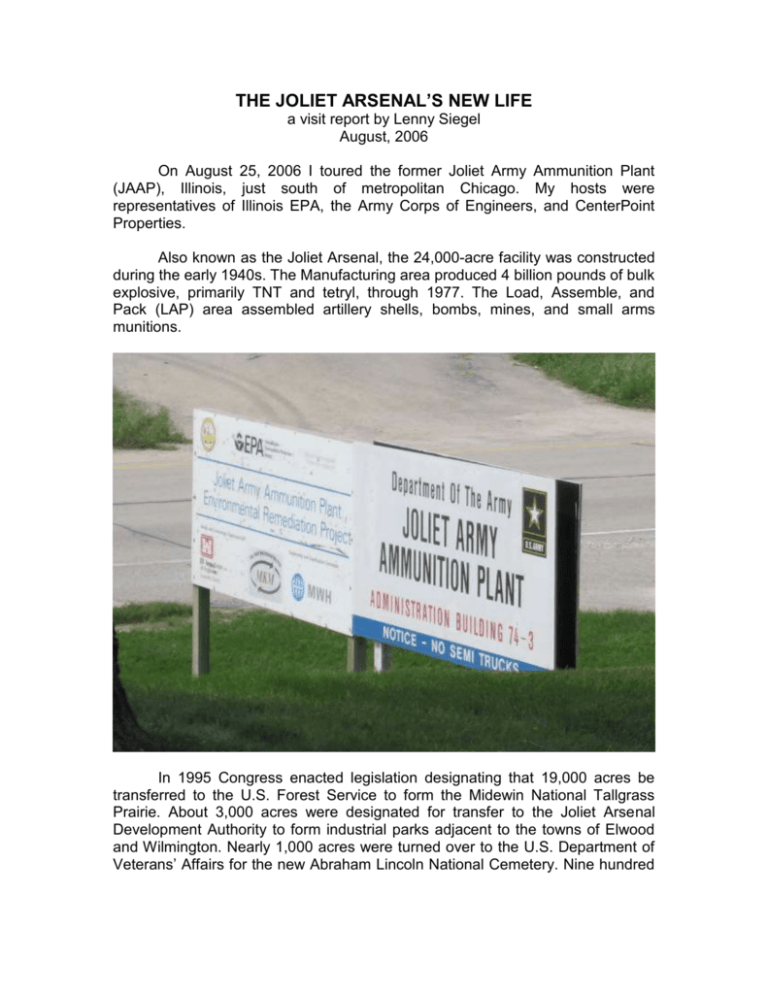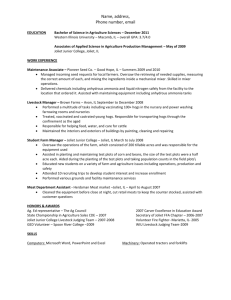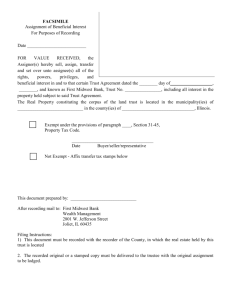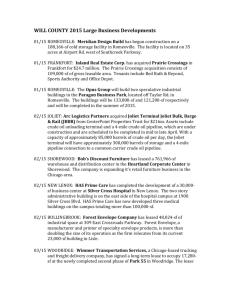Joliet Army Ammunition Plant, Illinois
advertisement

THE JOLIET ARSENAL’S NEW LIFE a visit report by Lenny Siegel August, 2006 On August 25, 2006 I toured the former Joliet Army Ammunition Plant (JAAP), Illinois, just south of metropolitan Chicago. My hosts were representatives of Illinois EPA, the Army Corps of Engineers, and CenterPoint Properties. Also known as the Joliet Arsenal, the 24,000-acre facility was constructed during the early 1940s. The Manufacturing area produced 4 billion pounds of bulk explosive, primarily TNT and tetryl, through 1977. The Load, Assemble, and Pack (LAP) area assembled artillery shells, bombs, mines, and small arms munitions. In 1995 Congress enacted legislation designating that 19,000 acres be transferred to the U.S. Forest Service to form the Midewin National Tallgrass Prairie. About 3,000 acres were designated for transfer to the Joliet Arsenal Development Authority to form industrial parks adjacent to the towns of Elwood and Wilmington. Nearly 1,000 acres were turned over to the U.S. Department of Veterans’ Affairs for the new Abraham Lincoln National Cemetery. Nine hundred Joliet Visit 2 August, 2006 acres were set aside for a consolidated Will County landfill, also adjacent to Wilmington. Though JAAP was not closed under Base Realignment and Closure (BRAC) legislation, it is subject to the same environmental legal framework as BRAC bases. U.S. EPA listed both the Manufacturing Area and the LAP Area on the “Superfund” National Priorities List, in 1987 and 1989 respectively. Under the Community Environmental Response Facilitation Action (CERFA), about three quarters of the property were cleared for transfer early in the process. Additional parcels have been made available as they qualified. My brief visit suggested that at JAAP the regulatory agencies—Illinois EPA and U.S. EPA—and the Army have worked together well, and that the continuity of leadership at each agency has strengthened both their relationships and knowledge of the facility. In turn, a successful environmental program, in which over $100 million has already been spent, has enabled timely reuse. Finally, the plant’s strategic location has made its commercial redevelopment the envy of closing bases throughout the country. Excavation with blast wall in background Joliet Visit 3 August, 2006 The largest environmental cleanup challenge at Joliet was the pervasive soil contamination in the developed portion of the manufacturing area, the area designated for industrial redevelopment. The Army excavated 400,000 TNTladen cubic yards from this area, sampling as it went. It constructed a composting facility, mixing the soil with horse manure, wood chips, and corn waste in thre huge sheds. The clean soil is used entirely on the facility, filling in excavated areas and building up berms. However, not all the regrading is done by the Army. CenterPoint levels the land as it redevelops. While TNT batch processing was underway, wastewater—known as redwater because TNT turns red upon exposure to air—was released into a lagoon. The Army is finishing up its work in the lagoon area, preparing it for transfer, but during production the plant incinerated the red-water, forming mounds of ash. Today that ash is considered “special waste”—a category between hazardous waste and solid waste—and is being transferred to the new “Prairie View” landfill. The 1995 Legislation decreed that the landfill accept non-hazardous Army waste from the cleanup. Because it’s part of the former plant, no permit is required. Joliet Visit 4 August, 2006 Ash mound As elsewhere, the Army plans to backfill the excavated ash disposal area with clean soil from the composting operation. Two open-burning open-detonation areas, in the middle of the LAP parcel, were used to dispose of munitions. The Army Corps is preparing a geophysical investigation to remove unexploded and discarded munitions from those areas. It has already searched the surface for munitions and cleared the vegetation. These projects are being conducted with Installation Restoration funds, because they are necessary to address soil contamination, but subsurface clearance of adjacent areas—where kick-out from detonations may have spread unexploded munitions—awaits the availability of Munitions Response funding. Joliet Visit 5 August, 2006 OB/OD area Other wastes are being consolidated on-site, in areas such as the M-11 landfill on the Manufacturing side of the plant. The Army has awarded a performance-based contract to MKM Engineering to address landfills and groundwater sites. For a fixed price, MKM is responsible for meeting regulatory requirements for closeout at those sites. Thus far, the contract seems to be working well. Apparently the actual costs of remediation have turned out to be less than initial estimates. Joliet Visit 6 August, 2006 Landfill M-11 Perhaps the largest remaining task is the removal of buildings. The Army demolishes old buildings if necessary to conduct soil or water remediation, but otherwise demolition is considered the responsibility of the transferee—the developer or the Forest Service. Some of the buildings were “flashed” (burned) after the removal of asbestos pipe-lining and roofing. At Joliet, this did not engender the controversies that have arisen more recently at the Badger (Wisconsin) and Ravenna (Ohio) Army Ammunition Plants, over the burning of PCB coatings. Joliet Visit 7 August, 2006 Remains of one of the older LAP lines Some of the wood from buildings has been removed and reused. In fact, some of the shelving and beam facades in the Midewin Welcome Center come from the plant. Dealing with old buildings seems to be a small cost of redevelopment for the commercial areas, but eventually it will become a significant challenge for the Forest Service. In addition to receiving four assembly line complexes, it has inherited 392 concrete munitions-storage bunkers. Joliet Visit 8 August, 2006 Located near three Interstate Highways and major rail lines, Joliet’s redevelopers easily found new, economically viable uses. Burlington Northern Santa Fe operates a massive Intermodal (truck and train) transportation facility, facilitating the receipt and re-distribution of goods on an enormous scale. Container business is growing faster than the developers can provide space. Meanwhile, thousands of new cars and some classics have been unloaded from closed train cars and parked on the adjacent lots, awaiting distribution. Nearby, millions of square feet of warehouses have recently been built and are gradually being put to use. One of Walmart’s buildings, a distribution center, is more than 1.2 million square feet. Joliet Visit 9 August, 2006 Change at the Midewin National Tallgrass Prairie (MNTP), the nation’s first, is slower. Though 6,409 acres are now open to the public, the Forest Service‘s management plan calls for continuing cattle-grazing and corn and soybean production—as a way of preserving habitat and, I suspect, generating needed revenues. Unlike some other closed military bases—Fort Ord, California, for example—Joliet was not an island of native habitat. Farming displaced most of the native ecology long before the military arrived. The Management Plan explains, “It may be decades before Midewin’s restored prairie begins to resemble the prairies once found in northeast Illinois.” Restoration of native prairie “will require as many as 350 different species of grasses and wildflowers,” so MNTP has established three native seed gardens. Joliet Visit 10 August, 2006 Most of the cleanup of the former Joliet Army Ammunition Plant is done, but completion will take several more years. Still, most of land at the two Superfund sites that comprise it have been made available for reuse. The new uses are underway, but removing buildings and debris, as well prairie restoration, will take decades.









